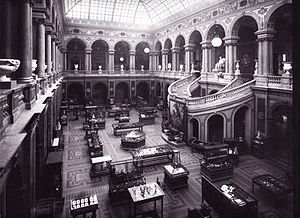
Stieglitz Museum of Applied Arts
Encyclopedia

Applied art
Applied art is the application of design and aesthetics to objects of function and everyday use. Whereas fine arts serve as intellectual stimulation to the viewer or academic sensibilities, the applied arts incorporate design and creative ideals to objects of utility, such as a cup, magazine or...
ranks among the most significant museum
Museum
A museum is an institution that cares for a collection of artifacts and other objects of scientific, artistic, cultural, or historical importance and makes them available for public viewing through exhibits that may be permanent or temporary. Most large museums are located in major cities...
s in Saint Petersburg
Saint Petersburg
Saint Petersburg is a city and a federal subject of Russia located on the Neva River at the head of the Gulf of Finland on the Baltic Sea...
, Russia
Russia
Russia or , officially known as both Russia and the Russian Federation , is a country in northern Eurasia. It is a federal semi-presidential republic, comprising 83 federal subjects...
.
The project had its beginnings in 1878 when Baron Alexander von Stieglitz
Alexander von Stieglitz
Baron Alexander von Stieglitz was a Russian philanthropist and financier. He was the first governor of the State Bank of the Russian Empire, the predecessor organization to today's Central Bank of the Russian Federation.-Early life and education:...
(1814-84), a millionaire philanthropist, donated funds to build a museum for the benefit of students of the Central School of Engineering Design, which had been established by him earlier. The new museum was to accommodate Stieglitz's private collection of rare glassware, porcelain
Porcelain
Porcelain is a ceramic material made by heating raw materials, generally including clay in the form of kaolin, in a kiln to temperatures between and...
s, tapestries, furniture, and tiled stoves.
The museum's first director, Maximilian Messmacher
Maximilian Messmacher
Maximilian Egorovich Messmacher was a Russian architect of German ancestry. He attended the School of Painting of St. Petersburg Society for the Encouragement of Arts and thereafter the Imperial Academy of Arts, graduating in 1866...
, based his design upon a similar museum in Vienna
Vienna
Vienna is the capital and largest city of the Republic of Austria and one of the nine states of Austria. Vienna is Austria's primary city, with a population of about 1.723 million , and is by far the largest city in Austria, as well as its cultural, economic, and political centre...
. Constructed between 1885 and 1896, the building is an example of the Neo-Renaissance
Neo-Renaissance
Renaissance Revival is an all-encompassing designation that covers many 19th century architectural revival styles which were neither Grecian nor Gothic but which instead drew inspiration from a wide range of classicizing Italian modes...
at its most stylistically forceful. The ground floor with arched windows is heavily rusticated
Rustication (architecture)
thumb|upright|Two different styles of rustication in the [[Palazzo Medici-Riccardi]] in [[Florence]].In classical architecture rustication is an architectural feature that contrasts in texture with the smoothly finished, squared block masonry surfaces called ashlar...
and the upper storey is turgid with ornate details and statuary. The central hall is set between two-storey Italianate arcades, while interiors of other halls are styled so as to conform with items exhibited therein. A room patterned after the Terem Palace
Terem Palace
Terem Palace or Teremnoy Palace is a historical building in the Moscow Kremlin, Russia, which used to be the main residence of the Russian tsars in the 17th century. Its name is derived from the Greek word τερεμνον...
particularly stands out as "an opulent knockout", in the words of Tom Masters of the Lonely Planet
Lonely Planet
Lonely Planet is the largest travel guide book and digital media publisher in the world. The company is owned by BBC Worldwide, which bought a 75% share from the founders Maureen and Tony Wheeler in 2007 and the final 25% in February 2011...
.
Out of some 30,000 items stored in the museum at the time of the Russian Revolution of 1917
Russian Revolution of 1917
The Russian Revolution is the collective term for a series of revolutions in Russia in 1917, which destroyed the Tsarist autocracy and led to the creation of the Soviet Union. The Tsar was deposed and replaced by a provisional government in the first revolution of February 1917...
, the Communist authorities handed over the most precious exhibits to the Hermitage Museum
Hermitage Museum
The State Hermitage is a museum of art and culture in Saint Petersburg, Russia. One of the largest and oldest museums of the world, it was founded in 1764 by Catherine the Great and has been opened to the public since 1852. Its collections, of which only a small part is on permanent display,...
. The Stieglitz Museum continued as a branch of the Hermitage until 1926, when it was abolished, only to be restored three years later as a separate institution. During the Soviet years luxurious interiors fell into disrepair, with one hall used as a gym
Gym
The word γυμνάσιον was used in Ancient Greece, that mean a locality for both physical and intellectual education of young men...
, its walls painted over. It was not until the fall of the Soviet Union that slow and painstaking restoration began.

